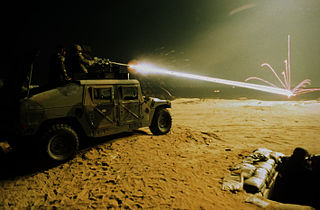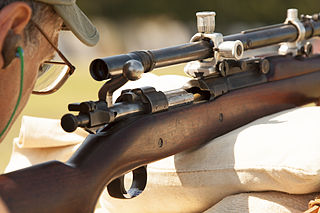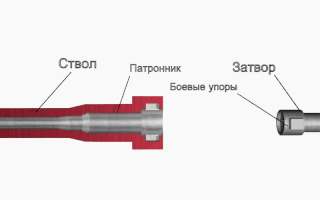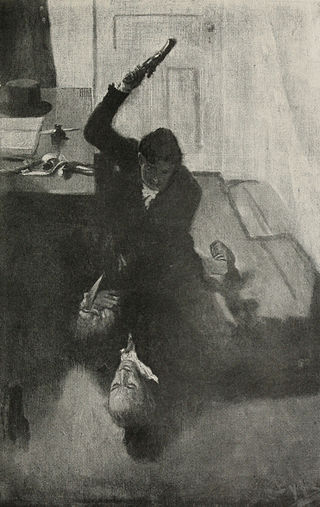Related Research Articles

A firearm is any type of gun that uses an explosive charge and is designed to be readily carried and used by an individual. The term is legally defined further in different countries.

Gun safety is the study and practice of using, transporting, storing and disposing of firearms and ammunition, including the training of gun users, the design of weapons, and formal and informal regulation of gun production, distribution, and usage, for the purpose of avoiding unintentional injury, illness, or death. This includes mishaps like accidental discharge, negligent discharge, and firearm malfunctions, as well as secondary risks like hearing loss, lead poisoning from bullets, and pollution from other hazardous materials in propellants and cartridges. There were 47,000 unintentional firearm deaths worldwide in 2013.

Ballistics is the field of mechanics concerned with the launching, flight behaviour and impact effects of projectiles, especially ranged weapon munitions such as bullets, unguided bombs, rockets or the like; the science or art of designing and accelerating projectiles so as to achieve a desired performance.

A semi-automatic pistol is a handgun that automatically ejects and loads cartridges in its chamber after every shot fired. Only one round of ammunition is fired each time the trigger is pulled, as the pistol's fire control group disconnects the trigger mechanism from the firing pin/striker until the trigger has been released and reset.

A ricochet is a rebound, bounce, or skip off a surface, particularly in the case of a projectile. Most ricochets are caused by accident and while the force of the deflection decelerates the projectile, it can still be energetic and almost as dangerous as before the deflection. The possibility of ricochet is one of the reasons for the common firearms safety rule "Never shoot a bullet at a flat, hard surface." Ricochets can occur with any caliber, but short or round ricocheting bullets may not produce the audible whine caused by tumbling irregular shapes. Ricochets are a hazard of shooting because, for as long as they retain sufficient velocity, ricocheting bullets or bullet fragments may cause collateral damage to animals, objects, or even the person who fired the shot.

The chamber of a firearm is the cavity at the back end of a breechloading weapon's barrel or cylinder, where the ammunition is inserted before being fired. The rear opening of the chamber is the breech, and is sealed by the breechblock or the bolt.
Articles related to criminology and law enforcement.

Gunshot residue (GSR), also known as cartridge discharge residue (CDR), gunfire residue (GFR), or firearm discharge residue (FDR), consists of all of the particles that are expelled from the muzzle of a gun following the discharge of a bullet. It is principally composed of burnt and unburnt particles from the explosive primer, the propellant (gunpowder), and vaporized lead. The act of firing a bullet incites a very violent explosive reaction that is contained within the barrel of the gun, which can cause the bullet, the barrel, or the cartridge to become chipped. Meaning gunshot residue may also included metal fragments from the cartridge casing, the bullets jacket, as well as any other dirt or residue contained within the barrel that could have become dislodged.

A slamfire is a discharge of a firearm occurring as a cartridge is being loaded into the chamber. Some firearms are designed to slamfire, but the term also describes a malfunction of self-loading firearms. Shooters accustomed to firearms requiring trigger activation for discharge may be unprepared for a slamfire discharge.

A contact shot is a gunshot wound incurred while the muzzle of the firearm is in direct contact with the body at the moment of discharge. Contact shots are often the result of close-range gunfights, suicide, or execution.
Calvin Hooker Goddard was a forensic scientist, army officer, academic, researcher and a pioneer in forensic ballistics. He examined the bullet casings in the 1929 St. Valentine's Day Massacre and showed that the guns used were not police issued weapons, leading the investigators to conclude it was a mob hit.

A comparison microscope is a device used to analyze side-by-side specimens. It consists of two microscopes connected by an optical bridge, which results in a split view window enabling two separate objects to be viewed simultaneously. This avoids the observer having to rely on memory when comparing two objects under a conventional microscope.
The Integrated Ballistics Identification System, or IBIS, is the brand of the Automated firearms identification system manufactured by Forensic Technology WAI, Inc., of Montreal, Canada.
In the United Kingdom police firearm policy varies by constituent countries. In Northern Ireland, all police officers carry firearms whereas in the rest of the United Kingdom, firearms are carried only by specially-trained firearms officers. The arming of police in Great Britain is a much debated topic.
The following are terms related to firearms and ammunition topics.

Pistol-whipping or buffaloing is the act of using a handgun as a blunt weapon, wielding it as an improvised club. Such a practice dates to the time of muzzle loaders, which were brandished in such fashion in close-quarters combat once the weapon's single projectile had been expended.

In firearms, a safety or safety catch is a mechanism used to help prevent the accidental discharge of a firearm, helping to ensure safer handling.
In the United States, certification and licensure requirements for law enforcement officers vary significantly from state to state. Policing in the United States is highly fragmented, and there are no national minimum standards for licensing police officers in the U.S. Researchers say police are given far more training on use of firearms than on de-escalating provocative situations. On average, US officers spend around 21 weeks training before they are qualified to go on patrol, which is far less than in most other developed countries.

The SIG Sauer P320 is a modular semi-automatic pistol made by SIG Sauer, Inc., SIG Sauer's American branch. It is a further development of the SIG Sauer P250, utilizing a striker-fired mechanism in lieu of a double action only hammer system. The P320 can be chambered in 9×19mm Parabellum, .357 SIG, .40 S&W, .45 ACP, and 10mm Auto and can be easily converted from one caliber to another; a change from .357 SIG to .40 S&W requires only a barrel change; a change from 9mm to .357 SIG or .40 S&W is accomplished using a caliber exchange kit.

Forensic firearm examination is the forensic process of examining the characteristics of firearms or bullets left behind at a crime scene. Specialists in this field try to link bullets to weapons and weapons to individuals. They can raise and record obliterated serial numbers in an attempt to find the registered owner of a weapon and look for fingerprints on a weapon and cartridges.
References
- ↑ Drop test a sig p320 yes it goes BANG!! 1st time on carpet!. dennis1979gm. 8 August 2017. Archived from the original on 19 November 2020. Retrieved 2 October 2021– via YouTube.
- ↑ SKS Firing Pin Sticks Forward. Murraysguns. 18 February 2015. Archived from the original on 27 December 2020. Retrieved 2 October 2021– via YouTube.
- ↑ How to accidentally discharge your pistol properly. GPS. 18 December 2016. Archived from the original on 2 July 2021. Retrieved 2 October 2021– via YouTube.
- ↑ Ammunition Cook-Off. SmallArmsUser. 18 July 2017. Retrieved 2 October 2021– via YouTube.
- ↑ Trevino, Abel. "Proper Weapons Practices Key to Ending Negligent Discharge Incidents in Iraq." army.mil. United States Army. 1 March 2007.
- ↑ Cunningham, Vernon (9 January 2014). "Negligent discharge: Don't be that guy". Joint Base Elmendorf-Richardson, USAF. Retrieved 18 December 2014.